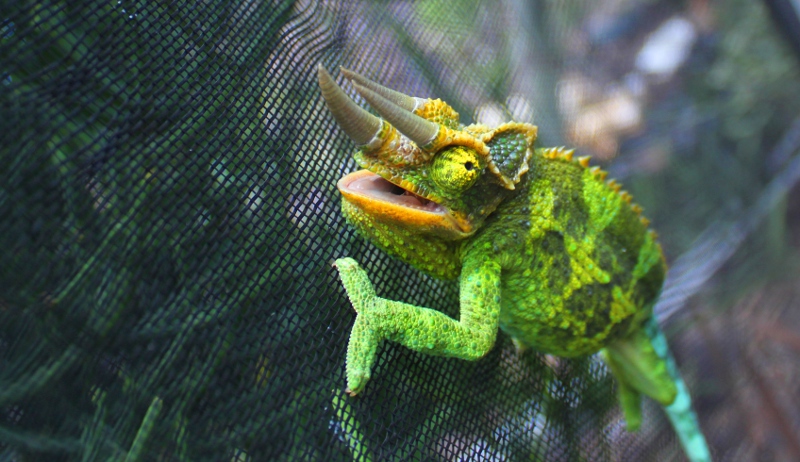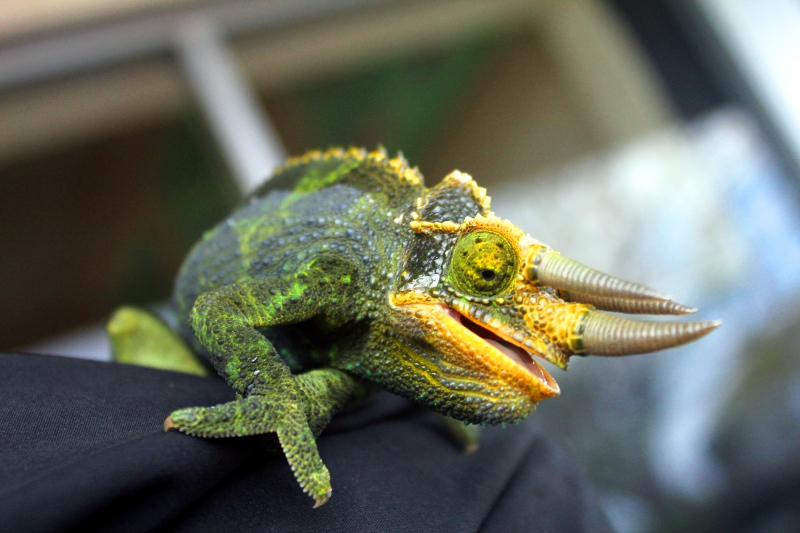
In 1972 Robin Ventura, a pet shop owner in Kaneohe on Oahu, obtained a Hawaii State Dept. of Agriculture permit to import Jackson’s Chameleons from Kenya to Hawaii in order to sell them in his shop. When the chameleons arrived they were unhealthy, thin, and dehydtrated, so he released them into a tree in his back yard to regain their strength believing that he could retrieve them later when they were healthy.
Of course, as is often the case when new species are introduced into a favorable environment, the lizards quickly spread from Mr. Ventura’s back yard into the Ko’olau mountains behind Kaneohe. The original shipment of Jackson’s Chameleons to Hawaii was only several dozen, but the numbers quickly grew. All Hawaiian chameleons are descended from the original shipment to Ventura’s pet shop in 1972. In 1981 Kenya stopped exporting Jackson’s Chameleons, so if you buy a Jackson’s Chameleon on the mainland, it most likely has Hawaiian origins. In its original territory in Kenya Jackson’s are found on the slopes of Mt. Kenya between 6000 and 8000 feet. On Hawaii’s Big Island Jackson’s were introduced into several areas in Kona in the late 80’s and early 90’s, but have since expanded to nearly the entire island, including many scrublands and desert areas. They can be found in the lava desert of Ocean View, the Cold, wet, ancient forests of Volcano, and in rain forests throughout the island. Jackson’s are a common sight in Hilo and Kona, often showing up in gardens and back yards.

With their expressively human-like face and color changing ability, Jackson’s Chameleons are often welcome visitors and are commonly kept as pets. Contrary to popular belief, chameleons do not change color strictly for camouflage purposes. Coloration is based on the lizard’s emotional state due to things like interaction and proximity to other chameleons, light, temperature, and response to outside stress or predators. These color changes do camouflage the animal, but they also act as visual cues to other chameleons as a way of conveying information. A contrasting pattern of bright green and black may be saying “I’m upset and it’s cold outside” to other members of the species.
One way to spot chameleons is to search for them at night in the jungle. May Chameleons will turn white and crawl to the end of a tree limb when night falls. On a nighttime hike with a flashlight through the jungle one may only need to look up in order to notice the temporarily white lizards sleeping in the branches.
If you spend enough time outside in Hawaii you’re bound to see a Jackson’s Chameleon sooner or later. This captivating, highly specialized lizard is non-native to the Hawaiian islands, but has been shown to be non-invasive in its impact on Hawaiian insect life. Colorful, expressive, and unique, you may see this newcomer to the islands just about anywhere.
